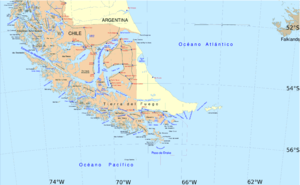Operation Mikado
| Operation Mikado | |
|---|---|
| Part of Rio Grande, Tierra del Fuego, Argentina | |
| Planned | May 1982 |
| Planned by | Brigadier Peter de la Billière |
| Target | Super Étendard squadron of the Argentine Navy |
| Executed by | Special Air Service |
| Outcome | Operation cancelled |
Operation Mikado was the code name of a military plan by the United Kingdom to use Special Air Service troops to attack the home base of Argentina's five Super Etendard strike fighters at Río Grande, Tierra del Fuego, during the 1982 Falklands War.[1] Brigadier Peter de la Billière[2] was in charge of planning the operation.
The British Task Force had been successfully attacked by these Argentinean aircraft using French
According to the plan, the C-130s would be kept on the tarmac with engines running while the men of B Squadron SAS performed their mission. If the C-130s survived, then they would head for the Chilean air base at Punta Arenas.[4] If not, the surviving members of the SAS Squadron and aircrew would use whatever transport available on the airfield to make their way to the Chilean border, about 50 miles to their west.[2]
Planned operation
Preliminary reconnaissance

A preliminary reconnaissance mission on Río Grande, code-named Operation Plum Duff, was launched from HMS Invincible on the night of 17/18 May, as a prelude to the attack. The operation consisted of transporting a small SAS team to the Argentine side of Tierra del Fuego on a stripped down Royal Navy Westland Sea King HC.4. The original plan was for the SAS team to march to the Rio Grande air base from the drop-off point and to set up an observation post to collect intelligence on the base's defences.[3][4]
The mission required that the Sea King helicopter travel a distance close to its maximum
The aircraft, with a three-man crew and an eight-man SAS team, took off from Invincible at 0015 hrs on 18 May. The aircraft inadvertently passed close to an Argentinian
According to Argentine reports, the helicopter was tracked by the radar of the destroyer
Abandonment of mission
By this time, Operation Mikado, which was already seen by experienced SAS members to be a suicide mission, was considered to be impossible to pull off, due to the loss of the element of surprise and due to British intelligence discovering that the Argentines enjoyed far better radar coverage than initially expected.[2] As a consequence, the airborne assault plan attracted considerable hostility from some members of the SAS, which ultimately led to one sergeant submitting his resignation shortly before the team was due to fly out to Ascension and to the squadron's commander being relieved and replaced by the regiment's second-in-command.[2][4] The lack of on-site intelligence meant that the British forces did not have a clear idea of how Rio Grande was defended, nor any guarantees that the Super Etendards or the Exocets would even be there if an operation took place. British forces also had no information on how the base was organized and did not know where the Exocets or pilots were located.[3]
Rumoured secondary plan
Contrary to rumours, no plan was devised to infiltrate the SAS into Argentina by Royal Navy submarine HMS Onyx.[2][4] The Argentine Navy claims that the Bouchard had shelled a submarine and a number of inflatable boats while on patrol two miles off Rio Grande, at the position 53°43′38.04″S 67°42′0″W / 53.7272333°S 67.70000°W on the evening of 16 May 1982.[4][6]
Assessment
Ultimately, the British Government acknowledged that there was a strong likelihood that the operation would have failed.[3] After the war, it was revealed that the Rio Grande area was defended by four Argentine Navy Marine Corps battalions, some of whose officers had been trained in the UK by the SBS years earlier.[4][10]
After the war, Argentine marine commanders stated that they were expecting a special forces attack, but never expected a Hercules to land directly on their runways, although they would have pursued British forces even into Chilean territory in case of attack.[11] The operation's failure would have been a propaganda disaster for the British forces, and conversely a morale boost for Argentina.[3][4]
References
- ^ The SAS VS The Exocet from www.eliteukforces.info
- ^ a b c d e f g "SAS 'suicide mission' to wipe out Exocets". The Daily Telegraph. 2002-03-08. Retrieved 2011-12-16.
- ^ a b c d e f g "The SAS vS the Exocet". Retrieved 2011-12-16.
- ^ a b c d e f g h i j Ewen Southby-Tailyour, Exocet Falklands
- ^ ISBN 978-1844158041
- ^ a b El Bouchard y el Fracaso de la Operación Británica Mikado by Eugenio L. Facchin y José L. Speroni (in Spanish)
- ISBN 9781783032020.
- ^ "Mikado: la operación que no fue" Archived 2009-04-22 at the Wayback Machine Clarín newspaper, 31 March 1996 (in Spanish)
- ^ La compañía fantasma que le disparó al misterioso Sea King Clarín newspaper, 21 May 2007 (in Spanish)
- ISBN 0-14-010767-3
- ISBN 987-43-3641-2. (in Spanish)
Further reading
- "Former Yeovilton pilot talks about 'Operation Certain Death'". BBC Somerset. 2008-10-28. Retrieved 2014-08-31.
- Muñoz, Jorge (2005). Ataquen Río Grande - Operación Mikado (in Spanish). Buenos Aires, Argentina: Instituto de Publicaciones Navales. ISBN 978-9508990518. Retrieved 2014-08-31.
- Southby-Tailyour, Ewen (2014). Exocet Falklands: The Untold Story of Special Forces Operations. Pen and Sword. ISBN 9781783463879. Retrieved 3 January 2015.
